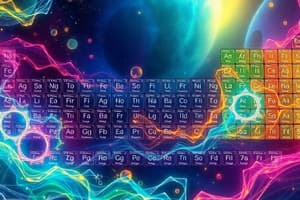Podcast
Questions and Answers
What is the ion for Hydrogen?
What is the ion for Hydrogen?
- H⁺ (correct)
- H₂
- H⁻
- H⁴
What is the ion for Lithium?
What is the ion for Lithium?
Li⁺
What is the ion for Sodium?
What is the ion for Sodium?
Na⁺
What is the ion for Potassium?
What is the ion for Potassium?
What is the ion for Rubidium?
What is the ion for Rubidium?
What is the ion for Cesium?
What is the ion for Cesium?
What is the ion for Francium?
What is the ion for Francium?
What is the ion for Beryllium?
What is the ion for Beryllium?
What is the ion for Magnesium?
What is the ion for Magnesium?
What is the ion for Calcium?
What is the ion for Calcium?
What is the ion for Strontium?
What is the ion for Strontium?
What is the ion for Barium?
What is the ion for Barium?
What is the ion for Radium?
What is the ion for Radium?
What is the ion for Scandium?
What is the ion for Scandium?
What is the ion for Yttrium?
What is the ion for Yttrium?
What is the ion for Lanthanum?
What is the ion for Lanthanum?
What is the ion for Actinium?
What is the ion for Actinium?
What is the ion for Aluminum?
What is the ion for Aluminum?
What is the ion for Silver?
What is the ion for Silver?
What is the ion for Zinc?
What is the ion for Zinc?
What is the ion for Fluorine?
What is the ion for Fluorine?
What is the ion for Chlorine?
What is the ion for Chlorine?
What is the ion for Bromine?
What is the ion for Bromine?
What is the ion for Iodine?
What is the ion for Iodine?
What is the ion for Astatine?
What is the ion for Astatine?
What is the ion for Oxygen?
What is the ion for Oxygen?
What is the ion for Sulfur?
What is the ion for Sulfur?
What is the ion for Selenium?
What is the ion for Selenium?
What is the ion for Tellurium?
What is the ion for Tellurium?
What is the ion for Polonium?
What is the ion for Polonium?
What is the ion for Nitrogen?
What is the ion for Nitrogen?
What is the ion for Phosphorus?
What is the ion for Phosphorus?
What is the ion for Arsenic?
What is the ion for Arsenic?
What is the ion for Antimony?
What is the ion for Antimony?
What is the ion for Bismuth?
What is the ion for Bismuth?
Flashcards are hidden until you start studying
Study Notes
Cations
- Hydrogen has a positive ion represented as H⁺.
- Lithium's positive ion is designated as Li⁺.
- Sodium is associated with the positive ion Na⁺.
- Potassium is denoted as K⁺ in its ionic form.
- Rubidium has the positive ion Rb⁺.
- Cesium’s ion is known as Cs⁺.
- Francium is represented as Fr⁺ in its ionic state.
Dications
- Beryllium's ionic form is Be²⁺.
- Magnesium corresponds to the ion Mg²⁺.
- Calcium has the positive ion Ca²⁺.
- Strontium’s ion is Sr²⁺.
- Barium is denoted as Ba²⁺ in ionic form.
- Radium is represented as Ra²⁺.
Trications
- Scandium forms a positive ion represented as Sc³⁺.
- Yttrium corresponds to the ion Y³⁺.
- Lanthanum has the positive form La³⁺.
- Actinium's ion is denoted as Ac³⁺.
- Aluminum is associated with the positive ion Al³⁺.
- Silver is represented by Ag⁺ in its ionic state.
- Zinc has the ionic form Zn²⁺.
Anions
- Fluorine forms a negative ion represented as F⁻.
- Chlorine corresponds to the negative ion Cl⁻.
- Bromine is associated with the negative ion Br⁻.
- Iodine has the ionic form I⁻.
- Astatine is represented as At⁻ in its ionic state.
Dications and Tetranions
- Oxygen forms a negative ion as O²⁻.
- Sulfur corresponds to the ion S²⁻.
- Selenium is represented in its ionic form as Se²⁻.
- Tellurium has a negative ion noted as Te²⁻.
- Polonium is denoted as Po³⁻.
Trinions
- Nitrogen is associated with the negative ion N³⁻.
- Phosphorus forms an ion represented as P³⁻.
- Arsenic has the negative ion As³⁻.
- Antimony corresponds to the ion Sb³⁻.
- Bismuth is represented as Bi³⁻ in ionic form.
Studying That Suits You
Use AI to generate personalized quizzes and flashcards to suit your learning preferences.




